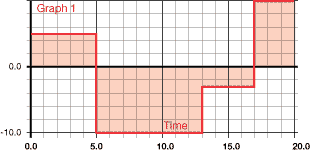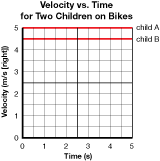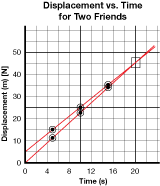Module 1—Motion
 Self-Check
Self-Check

© elenathewise/BigStockPhoto
SC 6. A ball rolls along a straight path with the following velocity and time intervals:
-
5.0 s at +5.0 m/s
-
8.0 s at –10.0 m/s
-
4.0 s at –3.0 m/s
-
3.0 s at +8.0 m/s
Use the simulation to produce a velocity-time graph for the data above. Click the area “Integrate” button (![]() ) and sweep out the area from left to right to determine the total displacement. Sweeping left to right gives a green area, and the simulation displays the area (integral) under Output.
) and sweep out the area from left to right to determine the total displacement. Sweeping left to right gives a green area, and the simulation displays the area (integral) under Output.
Complete the graph by drawing the velocity-time graph.

Total displacement (integral) as indicated in the simulation Output: _______ m
 Self-Check Answer
Self-Check Answer
SC 6.

Total displacement (integral) as indicated in the simulation “output”: –43.0 m
Module 1: Lesson 3 Assignment
Remember to submit the answer to TR 11 to your teacher as part of your Module 1: Lesson 3 Assignment.
 Try This
Try This
TR 11. A ball rolls along a straight path with the following velocity and time intervals:
-
3.0 s at +15.0 m/s
-
7.0 s at +20.0 m/s
-
6.0 s at –30.0 m/s
-
4.0 s at +3.5 m/s
Use the simulation to produce a velocity-time graph. Click the area “Integrate” button (![]() ), and sweep out the area from left to right to determine the following:
), and sweep out the area from left to right to determine the following:
- total displacement: _______ m
- displacement in the first 10 s: _______ m
- displacement in the last 10 s: _______ m
- displacement in the 5.0–15.0-s time interval: _______ m
 Self-Check
Self-Check
SC 7. Go to page 20 of your textbook and complete question 3 of “1.2 Check and Reflect.”
SC 8. Go to page 20 of your textbook and complete question 5 of “1.2 Check and Reflect.”
SC 9. Go to page 20 of your textbook and complete question 8 of “1.2 Check and Reflect.”
 Self-Check Answers
Self-Check Answers
SC 7. (i) D (ii) C (iii) A (iv) B
SC 8.

The camper’s final position is 7 km [W] of the camp.
SC 9.

The area under a velocity vs. time graph line is the displacement. The difference in areas for the graphs of the two children is the difference in their displacements.
distance A is from B = AreaA – AreaB
= (5.0 m/s)(5.0 s) – (4.5 m/s)(5.0 s)
= 2.5 m
Child A is 2.5 m farther from the point of origin than child B.
 Read
Read
Go to pages 14 to 17 of your textbook and read “Comparing the Motion of Two or More Objects on a Position-time Graph” to see examples of how problems involving two moving objects are solved.
SC 10. Go to page 20 of your textbook and complete question 12 of “1.2 Check and Reflect.” Use a graph in your solution.
 Self-Check Answer
Self-Check Answer
SC 10.
Given

Required
the time to catch up to your friend, and your displacement when you catch up to your friend
Analysis and Solution
Make a table of values to draw a displacement-time graph for the motion of your friend and yourself. The motions will be uniform, so the graphs will be straight lines. Observe the graph to see when the difference in displacements of your friend and yourself is 0.0 m.

| t (s) |
(m) |
(m) |
|---|---|---|
| 0 | 5 |
0 |
| 5 | 15 |
11.25 |
| 10 | 25 |
22.5 |
| 115 | 35 |
33.75 |
From the graph, the moment when the difference in displacements of your friend and yourself is 0.0 m occurs at 20 s. Reading the graph at that point indicates your displacement is 45 m.
Paraphrase
The time it takes you to catch up to your friend is 20 s, and your displacement when you catch up to your friend is 45 m [N].
 Watch and Listen
Watch and Listen
Watch the Comparing Motion Using a Position-Time Graph animation. Read the printed scenario at the bottom before you click on “Start Launch.” Look for the answer to SC 11 as you view the animation.
 Self-Check
Self-Check
SC 11. In the animation you just watched, how can you tell who won by looking at the graph lines?
 Self-Check Answer
Self-Check Answer
SC 11. The graph line with the greatest slope is the graph line of the winner. Another way of looking at it is the graph line that reaches the 100 m position in the shortest time is the graph line of the winner.
Module 1: Lesson 3 Assignment
Remember to submit the answers to TR 12, TR 13, and TR 14 to your teacher as part of your Module 1: Lesson 3 Assignment.